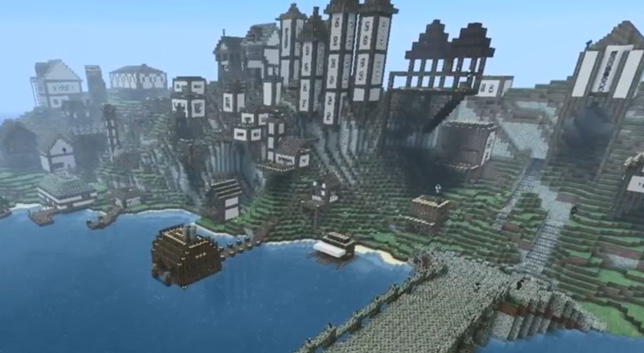Competition Calls for AI-Created Minecraft Settlements
- By Dian Schaffhauser
- 05/31/18

A sample human-created Minecraft settlement
Artificial intelligence has conquered poker, Jeopardy and Go — and now scientists want to see how creative AI can be too. A competition hosted by the NYU Tandon School of Engineering is challenging humans to create algorithms for producing adaptive settlements in Minecraft. (These are the villages and cities and other environments that players create at will in the online game.) The competition addresses a fairly new area of inquiry for machine learning in games: how to develop algorithms that can design rather than play.
People who pursue the "Settlement Generation Challenge" are being asked to write adaptive code that will on its own create a settlement for a given, unknown Minecraft map. Then, during the evaluation process, submitted algorithms will be run on three other previously unseen maps. The results will be judged not by a computer but by humans: a panel of experts that includes game designers, urbanists and architects. The judging criteria: adaptation to the environment (for example, does the settlement take advantage of the terrain?), functionality (does it keep mobs out?), narrative integration (could somebody looking at the settlement describe how it's different from other settlements?) and visual aesthetics (does it look believable?).
To give an idea of what the judges are looking for, the competition website offered examples of human-created settlements. For instance, a bay location ("Lakeside City") showed its buildings adapting to the varying elevation levels around the bay; and a "frozen summit" showed building materials that reflect that kind of setting.
Concocted at NYU's Game Innovation Lab, the competition is open to teams and individuals, whether students, gamers, Minecraft "modders," scientists or anybody else who likes to code in python or Java and likes creating worlds in Minecraft.
"Much of my own academic career has focused on posing procedural content generation in games as a research problem," said Julian Togelius, an NYU professor of computer science and engineering at and co-director of the lab, in a press release about the challenge. "Using AI methods to create game content initially wasn't taken seriously as a research problem. Now it is. It is also closely tied to the related field of computational creativity, which is about AI solutions to creating things, not just winning games or solving problems. This is a new, much less explored, and, I think, a lot more exciting area of AI research."
Michael Green, an NYU Tandon doctoral student, has developed a downloadable software framework that can be started with three lines of code. "All you need to supply is the code," he explained. "And the software is pretty easy to get started with." The framework was built on top of MCEdit, an open source Minecraft editor that allows the user to create and edit Minecraft map files.
Winners will be announced during the August 2018 Foundations of Digital Games Conference in Sweden. Then the researchers behind the project will publish the evaluation results, the competition maps, the settlements that were generated by the algorithms and the descriptions of the algorithms submitted by the participants. Those who enter are also being encouraged to publish their code, but that's not a requirement.
Submissions are due by June 30. Learn more at the competition website. A research paper that describes the project is available online.
About the Author
Dian Schaffhauser is a former senior contributing editor for 1105 Media's education publications THE Journal, Campus Technology and Spaces4Learning.